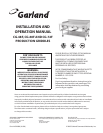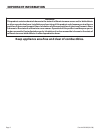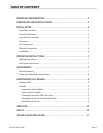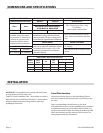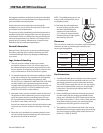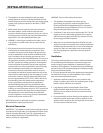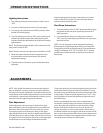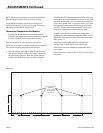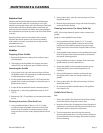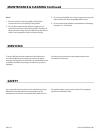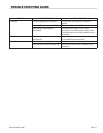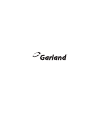
Part # 4520498 (01/08)Page 6
INSTALLATION Continued
4. The appliance must be isolated from the gas supply
piping system by closing its individual manual shut o
valve during any pressure testing of the gas supply piping
system at test pressures equal to or less than 1/2 PSIG.
(3.45 KPA).
5. Make certain that new piping, joints and connections
have been made in a clean manner and have been
purged, so that the piping compound, chips, etc., will not
clog valves and/or controls. Use pipe joint sealant that is
approved for use with liqueed petroleum gas.
6. WARNING: check all gas connections for leaks, using a
soap solution or similar means. Do not check with an
open ame.
7. Each thermostat controls one zone burner through a
combination dual solenoid/pressure regulator valve,
complete with a pressure test spigot. The gas pressure
on each combination valve must be checked when the
unit is installed to ensure that the gas pressure is the
same as specied on the Serial/Rating plate. For access to
the pressure test spigots, turn the main power switch to
the “OFF” position as a safety precaution, and hinge the
lower front panel downwards. Pressure test spigots are
located at the rear of each combination valve, including
pilot combination valves. When your manometer is
connected to the rst combination valve for test, turn
the manual shut o valve, located under the unit, to the
open position (valve handle in line with piping). Turn the
main power switch to “ON”. All thermostat dials should
be set to approximately 350°F (182°C). When all burners
are operating, check the reading on the manometer.
If not in accordance with the pressure specied on
the Serial/Rating Plate, adjust the combination valve
regulator accordingly. When satised with manometer
reading, turn the main power switch to “OFF”, remove the
manometer test tube and recap the test spigot. Repeat
this operation on each combination valve until each
pressure regulator is set correctly. Turn each thermostat
and the main power switch to “OFF.
NOTE: Make certain no electrical connections have been
disturbed before replacing front panels.
Electrical Connection
IMPORTANT: This appliance must be electrically grounded in
accordance with local codes, or in the absence of local codes,
with the Canadian Electrical Code C22.1 (latest edition) or
with the National Electrical Code ANSI/NFPA No. 70 (latest
edition), whichever is applicable.
WARNING: Electrical Grounding Instructions
1. This appliance is equipped with a three prong
(grounding) plug for your protection against shock
hazard and should be plugged directly into a properly
grounded three prong receptacle. Do not cut or remove
the grounding prong from this plug.
2. A separate 15 amp service must be provided. For 120 volt
usage, each unit is electrically equipped with a cord set
with a three prong plug which ts any standard 120 volt,
three prong grounded receptacle.
3. When the unit is ordered and built for 208/240 volt, the
supply line must be connected to the wiring terminations
located inside the terminal box. For ease in attaching the
supply line, there is a removable cover on the terminal
box. A wiring diagram is attached to the rear panel of
each unit.
Ventilation
The unit must be installed in a location in which the facilities
for ventilation permit satisfactory combustion of gas and
proper venting. Proper ventilation is imperative for good
operation of the appliance. The ideal method of ventilating a
gas unit is the use of a properly designed ventilating canopy,
which should extend at least
6” (152 mm) beyond all sides of the appliance (except against
the wall, if the canopy is a wall installation). This is usually
part of a mechanical exhaust system.
1. Appliances shall be located so as not to interfere with
proper circulation of air within the conned space. All gas
burners require sucient air to operate.
2. Large objects should not be placed in front of the
appliance which might obstruct the air ow through
the front. Do not obstruct the ow of combustion and
ventilation air.
3. Do not permit fans to blow directly at the appliance, and
wherever possible, avoid open windows adjacent to the
appliance sides and back; also wall type fans which create
air crosscurrents within the room.



